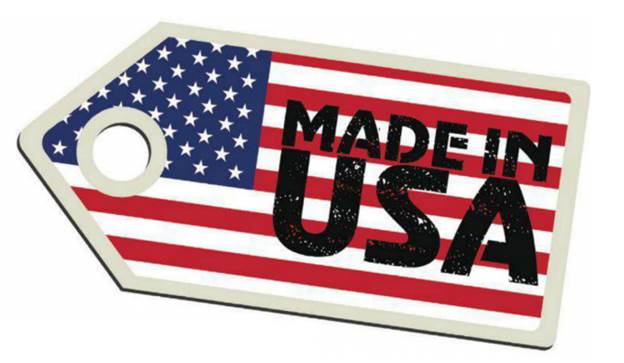Another type of
labeling law, enforce by U.S Customs and Border Protection with an assist from
the Department of Agriculture, requires imported goods to bear a
country-of-origin label when they enter the U.S. if an import combines
materials or processing from more than one country, the agency consider the
country of origin to be the last country in which a “substantial
transformation” occurred-for example, the place where a computer was
fabricated, not the country the supplied most parts.
The USDA’s
Agricultural Marketing Service is responsible for administering and enforcing
country-of-origin labeling of certain foods. Large retailers must use signs,
labels, or stickers to identify the birthplace of covered commodities (most
meat, fish, fresh or frozen fruits, vegetables, and some nuts). That’s why some
brands of salmon are labeled both “wild-caught Alaskan” and “Product of
Thailand.” The fish was caught in U.S. waters but took a detour to Asia to be
skinned and boned (to take advantage of cheaper labor) before making its return
voyage. Under the law, that side trip must be noted.
Bottom
line.
If you want to buy
American products, these tips should help:
·
Read
labels carefully, using the info above.
·
Consult
websites that name companies making products in the U.S.: amercansworking.com,
madeinamericaforever.com, and madeinusa.org.
·
Contact
a manufacturer directly.
Car wars: Comparing pedigrees
Most vehicles are
multinational, even those with iconic American nameplates, and many imports are
surprisingly red, white, and blue. Case in point: The Chevrolet Spark and
Toyota Sienna. Only 10 percent of the Chevy’s part is American or Canadian;
more than 75 percent (including the engine) are from Korea, where the vehicle
is assembled, and the automatic transmission is made in Japan. By contrast, 75
percent of the Sienna (including its engine) is American. It’s assembled in
Indiana.

Chevrolet Spark
We know those facts
because the American Automobile Labeling Act requires passenger vehicles,
pickup trucks, SUVs, and vans to bear labels specifying the value of their
U>S and Canadian parts (as a percentage of the total value of all car parts),
the country of assembly, and the country of origin of the engine and
transmission. That information is typically on the vehicle’s window sticker.

Toyota Sienna.
(Still) made in the USA
According to the Bureau of Labor
Statistics, American manufacturing lost almost 6 million jobs between 2000 and
2010. “Offshoring” became a buzzword with the implementation of the North
American Free Trade Agreement in 1994. But the more recent hemorrhaging of jobs
was due in large part to China’s entry into the World Trade Organization in
2011, notes Ron Hira, associate professor of public policy at the Rochester
institute of Technology. A decade of BLS data reveals heavy job losses across
more than a dozen manufacturing sectors, including apparel and textiles,
electrical equipment, iron and steel production, computers, glass, and leather
tanning and finishing.

Why
are foreign nations so appealing to manufacturers? Simple economics, for
starters
Why are foreign nations so appealing to
manufacturers? Simple economics, for starters. In 2010. “Offshoring” became a
buzzword with the implementation of the North American Free Trade Agreement in
1994. But the more recent hemorrhaging of jobs was due in large part to China’s
entry into the world Trade Organization in 2011, notes Ron Hira, associate
professor of public policy at the Rochester Institute of Technology. A decade
of BLS data revels heavy job losses across more than a dozen manufacturing
sectors, including apparel and textiles, electrical equipment, iron and steel
production, computers, glass, and leather tanning and finishing.
Why are foreign nations so appealing to
manufacturers? Simple economics, for starters. In 2010, compensation costs
(wages and benefits) for manufacturing jobs in the U.S were $34.74 per hour on
average, according to the BLS. That’s lower than in 13 northern and western
European countries, but far higher than costs in China: $1.36 per hour (in
2008), based on BLS estimates. Another manufacturing powerhouse, India, has
even lower hourly compensation costs than China.
But depending on the manufacturing sector,
labor may account for only a small fraction of operating costs. So China may
offer manufacturers “goodie packages” to relocate, including tax breaks,
low-cost land rental, an reduced utility costs, according to Hal Sirkin, a
senior partner with global-management consultants Boston Consulting Group. In
exchange, U.S companies might be required to take on local companies as business
partners or cut other deals with area businesses or municipalities.
The appeal of foreign countries may wane,
Sirkin says. “China gets more expensive every year. By 2015, Chinese wages will
average $6.15 per hour, still well below the U.S. minimum wage, but American
worker productivity is significantly higher. When you consider all the factors,
the true cost to manufacture goods from China will be only about 10 percent
cheaper than to make them domestically in another few years.”
National security issues and an iffy supply
chain are also concerns. “Natural disasters such as the 2011 tsunami in Japan
can disrupt the product pipeline, leading to shortages of parts, products, and
long shipping delays,” says J. Hoffecker, a managing director of global
business consultants Alix Parnters in New York. Exports By 2015, the Boston
Consulting Group predicts, cost advantages (in electricity, natural gas, and
labor) over Japan and several European countries in a range of industries will
give U.S exports a big boost. As a result, the group says, the U.S. could add
as many as 2.5 to 5 million manufacturing jobs by the end of the decade.
Jeff Faux, a distinguished fellow of the
Economic Policy Institute in Washington, D.C, is not sanguine about the nature
of those jobs. “When you think it through,” he says, “our default policy to
compete in the global economy over the long run is to lower the wages and
benefits of American workers, and no one at the top will admit that. There’ no
question a few jobs are coming back. However, they’re jobs that once paid $22
per hour and are now paying $12. Globalization isn’t the problem. The problem
is that we started to accelerate the opening of U.S markets to foreign goods,
but without preparing our workers for the brutalization of competition. For 30
years leaders have said we need to train and upgrade the skills of American
workers, but it needs to be done before signing these trade agreements, not
after the fact.”